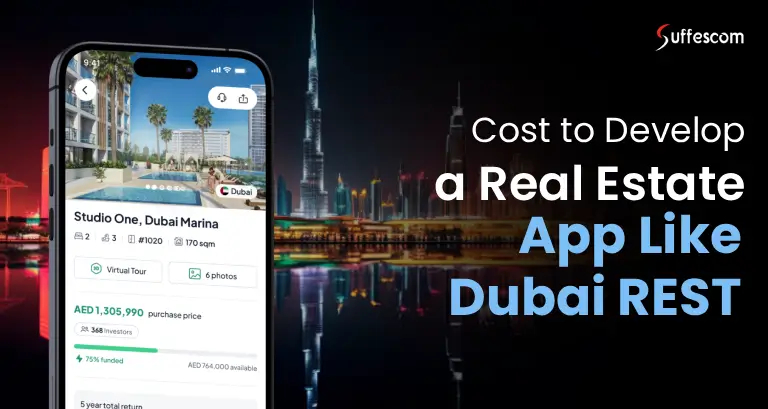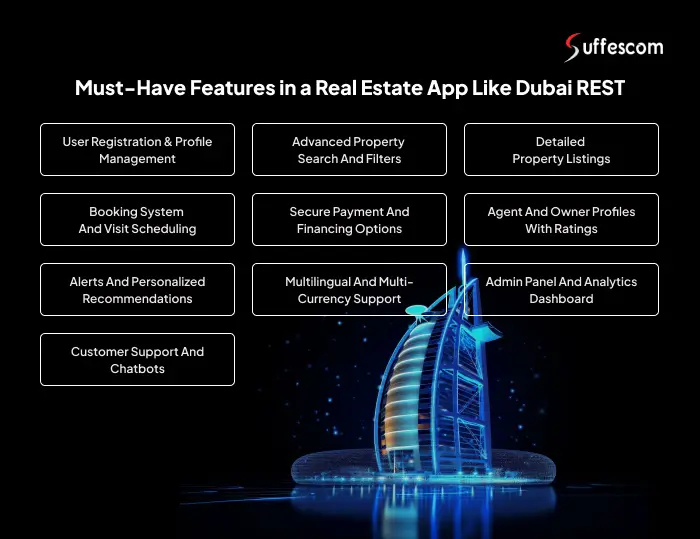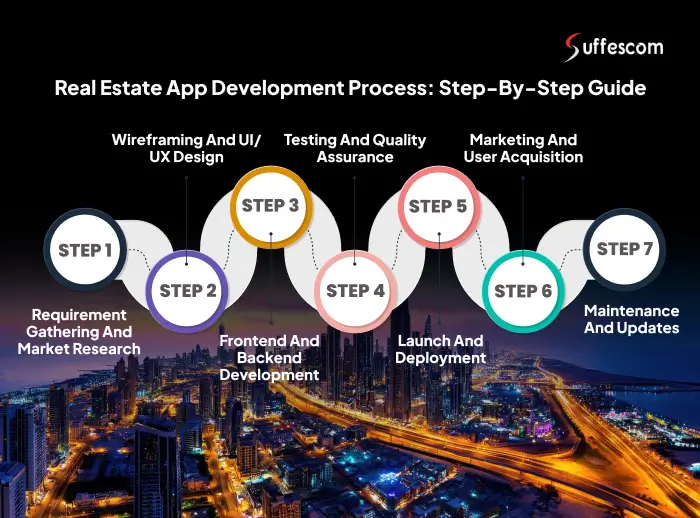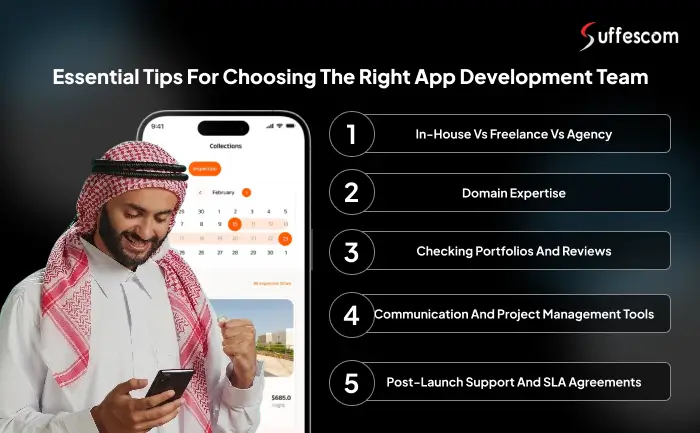How Much Does it Cost to Develop a Real Estate App Like Dubai REST ?

The Real estate industry is undergoing rapid change in 2026, and smart mobile apps are driving this transformation. In rising markets like the UAE, the real estate apps are transforming the traditional way of how people used to purchase or sell a property. Moreover, everything, from land searches to paperless contracts and smooth transactions, has made these apps more reliable to use.
One such example that stands out in this sector is the Dubai REST app, the official real estate app of the Dubai Land Department (DLD). It has set a benchmark in Proptech 2026, not just in the UAE, but globally. It provides end-to-end services that include smart contract signing, property valuation, and much more, all just from a smartphone in a few taps. This unique model has attracted developers, startups, and investors to discover more models that help both the public and private sectors' needs.
Moreover, an essential factor behind this surge is that Dubai real estate property prices increased by 27.5% annually, and the sales transaction volume exceeded 169,900 in 2024. This shows the rising requirements for apps like Dubai REST.
So, are you thinking about how much does it cost to develop a real estate app like Dubai REST? This guide will explore what makes it so effective and how you can develop a real estate app like Dubai REST. From cost estimates to critical features and development strategies, we will cover everything you need to know to develop such a high-performing real estate app.
Understanding Dubai REST: A Pioneer in Real Estate Apps
Dubai REST (Real Estate Self Transaction) is a real estate platform, launched in 2018, as part of Dubai’s vision of going paperless and a fully digital government. This mobile app allows property buyers, sellers, and brokers to fulfill real estate transactions and access services anytime without the need to go anywhere.
The app is launched in accordance with the Dubai 10x program, which encourages government departments to consider the latest technologies. The target market of the platform comprises property owners, tenants, and real estate brokers operating in the Dubai sector. It also accommodates investors outside the UAE interested in remotely managing their properties. Being supported by both English and Arabic languages and having direct integrations with the government, Dubai REST is on its way to becoming the most preferred platform when it comes to property demands within the emirate.
Over the past years, it has contributed significantly to reducing the number of physical visits to DLD offices to put the entire process of property transactions on an online platform. Whether it’s the idea of registering a lease, verifying ownership, or managing a title deed, the real estate app helps in doing all this via smartphone.
Core Value Proposition of an App like Dubai REST
The biggest value of Dubai REST lies in how it simplifies complex property transactions while following regulatory compliance and data accuracy. Every feature is developed in a way that makes the experience quicker and secure for all types of users.
One of the core strengths is its user-first design. In these apps, navigation is simple, with steps guiding everyone through transactions like Ejari registration. Most steps can be completed in a few taps, which decreases confusion, especially for users who are not tech-savvy.
Dubai REST also sets itself apart with innovative, fully digital services such as:
- Title deed digitization allows users to access and manage ownership records anytime.
- Real-time ownership verification through secure DLD data sources.
- Property valuation requests are made directly to the government.
- Smart leasing options for registering or cancelling rental agreements without brokers.
- Mortgage registration and clearance services are integrated with financial institutions.
Additionally, Dubai REST connects to UAE Pass, which allows users to verify their identity digitally.
Market Trends in Dubai Real Estate Apps
Dubai’s real estate sector has seen rapid growth in digital transformation, particularly since the COVID-19 pandemic accelerated the need for remote and paperless solutions. The customers and renters are demanding access to the property listings, sales transactions, lease agreements, and property verification through their smartphones.
With this transition, real estate apps are providing the property search feature that gives transparency, security, and self-service functionality. The main difference with Dubai REST is that it is not a product of the private sector, but is supported by the government; therefore, it holds a superior tracking level of credibility and uptake per the stakeholder groups.
However, it operates in a competitive space with several private PropTech platforms such as:
- An app like Bayut for property listing and marketplace platforms.
- Houza is a real estate portal focusing on verified listings.
- SmartCrowd is a real estate investment platform.
- Property Finder for property discovery with agent support.
These platforms focus on different aspects of the real estate app, like property discovery, marketing, or financing. But, in contrast, Dubai REST covers the complete legal and transactional process.
Must-Have Features in a Real Estate App Like Dubai REST

To ensure that you develop a high-performing app, you need to consider the real estate app features you will be providing to the user. Let’s explore the must-have features your real estate app should definitely have:
User Registration & Profile Management
The initial interaction users have with your real estate application is during the registration process. A quick sign-up is very important for decreasing drop-offs. Moreover, social media logins and verification through OTP can make this approach better and smoother.
Key elements include:
- Social media or email-based login.
- Role-based access for everyone.
- User profiles with document upload.
Advanced Property Search and Filters
Users should be able to find preferred listings in less time. Advanced filters save time and improve engagement. A combination of location, price range, property type, and other related amenities gives search results that are efficient.
Key elements include:
- Filters for price, bedrooms, type, and amenities.
- Map-based navigation for visual browsing.
- Heatmaps for trending or popular locations.
Detailed Property Listings
Each listing of the properties should provide a complete view. Virtual tours and high-resolution tours give consumers the confidence to go ahead. Additional aspects like neighbourhood views and floor plans help in decision-making.
Key elements include:
- 3D virtual tours and video walkthroughs.
- Property views, floor plans, and pricing.
- Nearby hospitals, schools, and transportation info.
Booking System and Visit Scheduling
Arranging property visits without the hassle of connecting with anyone makes real estate apps better for users. Additionally, reminders can minimize no-shows and increase efficiency.
Key elements include:
- Calendar integration with available timings.
- Auto-reminders via SMS, email, or app notifications.
- Rescheduling and cancellation options.
Secure Payment and Financing Options
Security is very important in real estate transactions. Users should have the option to manage payments and loans securely. Moreover, compliance with UAE Central Bank regulations and secure data handling policies is a must.
Key elements include:
- Integration with secure payment gateways.
- On-app EMI and mortgage calculators.
- E-Signature-enabled agreements.
Agent and Owner Profiles with Ratings
Trust is very important in any real estate app. So, including past listings and ratings will help users get more transparency. It also helps in improving the quality of services from owners and agents.
Key elements include:
- Detailed agent profiles with contact buttons.
- User-generated ratings and reviews.
- Verified owner or agency tags.
Alerts and Personalized Recommendations
Reminders or personalized suggestions in the application for new posts, planned tours, and price changes will help ensure that users do not miss anything.
Key elements include:
- Push alerts for saved search updates.
- Custom alerts for price drops or property status.
- AI engine for personalized property suggestions.
Multilingual and Multi-Currency Support
To serve Dubai's diverse audience, language and currency flexibility is a non-negotiable factor. This makes an inclusive experience for international users, investors, and expats.
Key elements include:
- Multiple language options (Arabic, English, etc.).
- Auto-conversion of currency based on user location.
- Region-specific formatting for dates, units, etc.
Admin Panel and Analytics Dashboard
In your real estate app, there should be a strong admin panel that allows platform managers to keep track of everything, such as activity and actions on reported issues.
Key elements include:
- User and property listing management.
- Real-time dashboard for key metrics.
- Fraud detection alerts and moderation tools.
Customer Support and Chatbots
Customer support is required in maintaining trust and solving queries promptly. AI chatbots reduce response time, while live chat ensures users can speak to a human when needed.
Key elements include:
- AI chatbot for 24/7 automated replies.
- Human agent support during business hours.
- Query the ticket system for detailed assistance.
Transform Your Real Estate Business!
With our mobile app development services, you can develop a Dubai REST-like platform that simplifies transactions for owners, tenants, and brokers.
Technical Architecture and Technology Stack For A Real Estate App
To develop an app like Dubai REST, a strong technical foundation is needed. This section of the blog explores which tools and technologies are needed in your app, from the frontend to the backend.
Frontend Technologies
This is the part that users see on the app; this should respond and load fast.
- The best frameworks to use would be Flutter and React Native, as they offer cross-platform development that functions on both iOS and Android systems.
- If your priority is a platform-specific app that targets one platform, you can also opt for:
- Swift for iOS apps
- Kotlin for Android apps
- UI frameworks like Material Design and Cupertino Widgets help deliver platform-native experiences.
Backend Development
The back end of your real estate app means the part where every business logic is handled, including data of the users, listings of properties, and much more.
- Node.js provides high performance for managing parallel requests and updates.
- Django is a strong framework in Python, ideal for developing safe real estate apps.
- Ruby on Rails can speed up app development with convention-over-configuration (CoC) features.
- Databases play a crucial role:
- MySQL for structured, relational data.
- MongoDB for unstructured data.
- Firebase for real-time data syncing and cloud-based storage.
Cloud and Hosting Services
Hosting services that are reliable guarantee that your real estate app is available from anywhere. It can scale as per your business demand.
- Amazon Web Services (AWS): Includes services such as S3, Lambda, and EC2.
- Google Cloud Platform (GCP): Ideal for using machine learning API's and Firebase.
- Microsoft Azure: Best for business-oriented security and with Microsoft-based services integration.
APIs and Third-Party Integrations
APIs streamline real estate app mobile development by adding features without the need to develop from scratch.
- Payment gateways:
- Stripe and PayPal for secure online payments.
- Local options like PayTabs or Telr can be considered for regional compliance.
- Map and location services:
- Google Maps for navigation and location-based features.
- Mapbox is a customizable alternative.
- SMS and email verification:
- Twilio, SendGrid, or Firebase Authentication.
Security Measures
When building a real estate app, your attention must be directed more towards security and compliance, which cannot be negotiable in this type of app.
- Data encryption: AES-256 encryption for data at rest and TLS for data in transit.
- Secure user authentication:
- OAuth 2.0, JWT tokens for session management.
- Biometric login and 2FA.
- Regulatory compliance:
- GDPR for handling the data of users.
- Local Dubai regulations related to digital property transactions.
Combining the right technologies and tools at each of the levels, your real estate app will be able to support the needs of the users as it will provide a seamless and expandable experience.
| Category | Tools and Technologies |
| Frontend | Flutter, React Native, Swift, Kotlin |
| Backend | Node.js, Django, Ruby on Rails |
| Database | MySQL, MongoDB, Firebase |
| Cloud & Hosting | Amazon Web Services (AWS), Google Cloud Platform (GCP), Microsoft Azure |
| APIs | RESTful APIs |
| Security | TLS Encryption, OAuth 2.0, JWT, 2FA, |
Detailed Cost Breakdown to Develop a Real Estate App Like Dubai REST
Developing an app like Dubai REST encapsulates numerous cost factors divided into different app development phases, tech stack, features, and complexity. Let’s explore the cost breakdown, which includes pre-development, feature-integration expense, and post-launch services.
Pre-development Expenses
Before writing a single line of code, there are certain foundational efforts that set the direction of your real estate app’s success. This pre-development phase is beneficial for defining scope, features, and target users. It usually takes 10-15% of the total expense.
1. Market Research and Competitor Analysis
A thorough analysis of such comparable competitors as Bayut, Property Finder, and apps supported by the government (such as Dubai REST) must be performed to comprehend the user expectations, gaps, and monetization strategies.
- Learn about local laws and regulatory requirements.
- Examine competing apps for UX.
- Determine your target audience preferences and device usage.
Estimated Cost: $2,000 – $4,000
Estimated Time: 2–3 weeks
2. UI/UX Design Investment
Great real estate apps emphasize simple property search and a responsive experience. This phase includes wireframing, prototyping, and high-fidelity visual design.
- Wireframes to map out the user journey.
- Interactive prototypes for early testing.
- High-fidelity UI design tailored for cross-platform responsiveness.
Estimated Cost: $3,000 – $5,000
Estimated Time: 3–4 weeks
Together, the pre-development costs can begin at $5,000 and go up to $9,000.
Development Cost by Feature
Feature-based pricing is the most accurate method to estimate development costs for a real estate app. Below is a detailed table showing each major feature, the estimated development time, and its corresponding cost range.
Cost Estimation Table
| Feature | Estimated Hours | Cost Range (AED) |
| User Registration/Profile | 100–140 hrs | AED 2000- 5000 |
| Property Search & Filters | 120–160 hrs | AED 2000- 4000 |
| Property Details/Media | 80–110 hrs | AED 1000- 5000 |
| Booking & Scheduling | 70–90 hrs | AED 2000- 6500 |
| Payment Integration | 80–110 hrs | AED 2000- 8500 |
| Agent Profiles & Ratings | 50–70 hrs | AED 2000- 5000 |
| Notifications & Alerts | 40–60 hrs | AED 1000- 5000 |
| Multilingual & Currency Support | 50–70 hrs | AED 1000- 4000 |
| Admin Panel & Analytics | 130–170 hrs | AED 5000- 10000 |
| Chat & Support Integration | 70–100 hrs | AED 3000- 8000 |
| Testing & Quality Assurance | 100–140 hrs | AED 3000- 9000 |
| Deployment & Maintenance | Ongoing | AED 1000- 5000 |
Other Costs To Consider
There are some other costs that you need to consider besides these for real estate mobile app development. These costs are also essential to know because if they may arise, it would be helpful to allocate your budget accordingly.
1. Marketing and User Acquisition
To reach tenants, landlords, and agents, your app will need aggressive digital promotion during the launch and post-launch phases.
- SEO-optimized landing pages
- Paid advertising on Google, Facebook, or regional platforms
- Influencer marketing or real estate partnership collaborations
2. Legal and Licensing Fees
Since real estate deals with transactions, leases, and verifying identities, your app will have to abide by the local laws of property and data privacy laws, which can increase overall costs.
- Legal documentation and disclaimers
- Licensing from the property or municipal authorities
- GDPR or DPL (Data Protection Law) compliance
3. Post-launch Updates and Scaling
When the app is live, it needs to be maintained, adding functionality, fixing bugs, and scaling with the number of users that come along.
- API updates, OS upgrades, and security patches
- Integration of new features based on user feedback
- Infrastructure upgrades for cloud and database performance
4. Support & Maintenance Team
Hiring dedicated customer support or technical personnel for live issue resolution improves user experience and retention.
- In-app support team or ticket system
- SLA-based technical support for crashes or bugs
Total Estimated Cost Range
Based on all the above, here’s the range for developing a real estate app similar to Dubai REST. The cost to develop an app like Dubai REST can range between $8,000 $20,000+.
How to Reduce Real Estate App Development Costs Without Compromising Quality
Developing a high-performing real estate app like Dubai REST will not necessarily cost huge sums of money right at the beginning. Using clear planning and strategic decisions, development costs can be considerably cut down without compromising the quality, scalability, and security of a product. The following are tested methods on how to streamline the expenses without compromising the quality.
Start with an MVP (Minimum Viable Product)
Developing comprehensive real estate applications will not only cost you, but will also be time-consuming. Build a Minimum Viable Product (MVP). Doing so will enable you to put a working version of the application out into the world with the main functionality and receive real feedback to iterate on easily.
Benefits of MVP development:
- Quicker time to market: Get to market faster with the basic functions, such as property search, user profiles, and payments.
- Tests that product-market fit: Analyze product-market fit at the early stage, rather than continuing to invest.
- Saves money on initial development: Only those features that are a high priority are pursued in the budget.
- Supports agile enhancements: There is a real-world user behaviour and needs basis for enhancements.
To take an example, the MVP of a Dubai REST-style app could incorporate functions such as the search of property listings, booking requests, and online documentation, but not such functionalities as advanced analytics and AI-based recommendations at first.
Use Cross-Platform Development Frameworks
Another effective way to cut costs is to select cross-platform frameworks, such as Flutter or React Native. These tools enable an application developer to write a single code base that will run on both the iOS and Android platforms.
Benefits of Cross-Platform
- Cheap prices of resources: You do not have to use additional iOS and Android development teams.
- Easy bug fixes and updates: An update is done once and is shared on both platforms.
- Natural performance: Flutter and React Native deliver fluid UI/UX of real estate applications.
It is perfect for start-ups or small businesses that want to continue delivering quality, and at the same time keep the cost to a manageable amount.
Outsource to Cost-effective Regions
It is costly to hire an internal staff in expensive places such as the US, the UK, or the UAE. The development of any real estate application can significantly reduce expenditures by outsourcing the services to cheaper areas of India, Eastern Europe, or Asia.
Key outsourcing advantages:
- Reduced per-hour rates: Developers in such countries as India or Ukraine usually charge half to three-quarters less than those in the West.
- Availability of qualified talent: There is a lot of skilled workforce in real estate and PropTech apps that have been outsourced.
- Flexible engagement models: Select the appropriate engagement model, such as fixed-price, hourly, or dedicated team, depending on your budget.
- Concentrating on core business: Hire the best real estate app development company to take care of the technology, but focus on marketing, expanding, and operations.
To achieve quality, the development agency should be reputable, have a track record with experience, and have clarity of communication and project management transparency.
Leverage Open-Source Tools and Plugins
Instead of building everything from scratch, make use of open-source frameworks and libraries, as well as prebuilt modules that support stable and secure features. These may reduce time and effort.
Useful open-source integrations for real estate apps:
- Map integrations: Avoid paid geography libraries, because open-source mapping libraries are available instead.
- Sign-in systems: Reduce work during the development of user login systems with Firebase Auth, Auth0, or OAuth tools.
- CMS platforms: Use tools that could be used to handle the content efficiently.
- Chat: Use ready-made technologies such as free-of-charge Rocket.Chat or Stream Chat that can be integrated, rather than developing it in-house.
Nevertheless, security, maintenance, and community support are the aspects that should always be assessed during the evaluation of tools to avoid vulnerability down the road.
Prioritize Core Features Over Extras Initially
One of the most common pitfalls in app development is overbuilding. Concentrate your early budget on those features that have an immediate effect on the user experience and the business value. Put in additional features after the application gains traction.
How to identify core vs. extra features:
- Required: Advertisement of properties, filtering, user profiles, payments, and reservations.
- Good-to-have: chat in the app, intelligent property recommendations, and augmented reality (AR) viewing of properties.
- Later add-ons: CRM integrations, analytics, multilingual support, and document automation.
Strategies to Make Your Real Estate App Like Dubai REST Stand Out
The key to success is to be able to compete in the current market, not to duplicate the existing ones, but to enhance them. These are five methods that will help your app stand out.
Integrate AI for Smarter Property Matching
AI can be used to study the behaviour, preferences, and budget of the users to provide hyper-relevant property suggestions. It learns with time and is more precise in its suggestions with each contact.
Differentiator: Search results that are personalized in a way that saves the user effort and boosts conversion.
Use Augmented Reality (AR) and Virtual Reality (VR) Tours
Virtual walkthrough enables users to visit homes without having to travel, and thus do this faster, aiding in making better decisions. AR overlays can display the position of furniture or what renovations can be done.
Important innovation: Remote 3D property tours that instill increased buyer confidence.
Blockchain for Transparent Transactions
Blockchain allows a non-tamperable, secure accounting of property and transactions. It reduces fraud, makes it easy to verify titles, and allows digitalizing the ownership lifecycle.
Standard benefit: Guaranteed trust, transparent, and safe legal deals.
Hyperlocal Market Insights and Analytics
Give users access to neighbourhood-specific data like rental trends, price comparisons, nearby schools, and commute times. Real-time insights help tenants and buyers make smarter decisions.
Key value: Data-backed decision-making powered by location intelligence.
Enhanced User Engagement with Gamification
Incorporate some gamified elements such as record keeping, rewarded stickers/badges, or reward points when tasks are completed, such as setting up a profile or scrolling through a specific number of listings.
Key outcome: Increased retention due to engaging user experiences.
Real Estate App Development Process: Step-by-Step Guide

The process of developing a real estate application, such as the Dubai REST, is a systematic procedure that entails functionality, as well as customer satisfaction. This is the outline of the process to get you through the concept, to launch, and beyond.
Requirement Gathering and Market Research
Development begins with an estimate of your application goals, targeted users, and specific features to include. This step includes competitor analysis, learning local real estate policies, and gathering the expectations of users. It establishes a basis where the solution is both user-friendly and compliant.
- Define core business needs and app functionality
- Analyze competitor apps in the same region
- Study regulatory frameworks and tech feasibility
Wireframing and UI/UX Design
This step involves creating visual layouts that outline the interaction of users with the app. The designers concentrate on developing a clean and easily understood interface so that searching for a property and navigating the app would be easy.
- Build user journeys for buyers, sellers, and agents
- Create low and high-fidelity wireframes
- Design a responsive UI for all screen sizes
Frontend and Backend Development
Once the designs are complete, developers start with the coding of the app. The frontend is user-friendly and fast, whereas the backend collects and stores information, provides property listings, user profiles, and payments with safety.
- Code the app interface using frameworks like React Native or Flutter
- Build backend infrastructure with scalable cloud services
- Integrate APIs for maps, payment, and property feeds
Testing and Quality Assurance
Prior to the release, the app is tested to the maximum to repair bugs, enhance performance, and ensure that it works fine on various devices and platforms. Both manual and automated testing are done.
- Run functionality and usability tests.
- Ensure compatibility across Android, iOS, and web
- Test for data privacy, security, and loading speed
Launch and Deployment
When the app is stable and perfect, it is published in app stores. A soft launch enables identification of any last-minute problems, and then there can be a full-scale release. App store optimization (ASO) is also done for better visibility.
- Deploy on Google Play Store and Apple App Store
- Set up backend servers and databases
- Configure analytics and crash monitoring tools
Marketing and User Acquisition
A marketing strategy that attracts users is deployed by means of digital channels. This encourages visibility and downloads during the early stages with early promotions, social proof, and influencer outreach.
- Run app install campaigns on Google and Meta
- Use referral bonuses and rewards to increase reach
- Build a landing page or mini-website to drive interest
Maintenance and Updates
On completion, the continual maintenance will be required to debug, introduce new improvements, and keep up with OS upgrades.
- Monitor performance and user behaviour via analytics
- Roll out periodic feature updates and patches
- Keep the app aligned with changing real estate laws
Essential Tips for Choosing the Right App Development Team

Finding the correct mobile app development company in Dubai is essential for the best results of your real estate app. The team should have both technical expertise and knowledge of the real estate field, in addition to transparent communication. Here's how to make the right choice:
In-House vs Freelance vs Agency
The decision of an in-house team vs freelancers vs an app development agency depends on your budget, timeline, and also the magnitude of your project:
- In-house teams ensure full control and convenient collaboration but are characterized by great expenses, infrastructure, and HR overheads.
- Freelancers are economical and flexible, yet they lack project continuity, especially if multiple specialists are required.
- Agencies offer a full-stack team of developers, designers, testers, and PMs, all equipped to deal with complicated projects. They provide confidence and a simplified delivery; however, they can be more expensive than freelancers.
Agencies can produce superior results on real estate apps with complex functions such as live listings, map integration, secure transactions, etc.
Domain Expertise
Real estate app development is not only a matter of clean code, as it demands knowledge of user groups (agents, buyers, and tenants), compliance with legal regulations, logic of listing properties, and integrations with MLS or local databases. It is necessary to hire a team that has worked in real estate or proptech before, or in location-based apps.
Checking Portfolios and Reviews
The record of success says a lot. Check the previous work that the team has undertaken, especially that which has a similarity to a real estate app. Look for:
- End user interface/experience
- Easy mobility and map behaviour
- Mobile responsive and loading speeds
You can also read testimonials of clients, Clutch or GoodFirms ratings, and LinkedIn recommendations to evaluate reputation and stability.
Communication and Project Management Tools
The development should be transparent. Ensure that the team utilizes common project management software such as Jira, Trello, or Asana. Slack, Zoom, and Teams help you get updates on a daily or weekly basis and can keep you up to speed.
- Sprint boards and dev progress access
- Every week, meeting schedules and communication protocols
- Assign a single point of contact (PM or lead dev)
Post-Launch Support and SLA Agreements
App deployment is just the beginning. Make sure that the team will offer post-launch support that will include:
- Bug fixes and crash monitoring
- Regular security updates
- Feature enhancements based on user feedback
A Service Level Agreement (SLA), which outlines response times, uptime, and update cycles. A quality support strategy will make your real estate application continue to execute and expand.
One such company that offers end-to-end real estate app development with technical depth, domain expertise, and reliable post-launch support is Suffescom.
Conclusion
In conclusion, creating a real estate app like Dubai REST needs precise planning around costs, features, and much more. Moreover, the overall real estate app development cost can differ based on your requirements. From design to latest tech stack, every component should align with the needs to provide users with the best outcome.
To succeed, plan your budget wisely and prioritize post-launch updates. Staying user-focused will help your app remain competitive in Dubai’s evolving property tech landscape. If you still have any questions? Partner with a mobile app development company in Dubai to get a customized roadmap!
Launch Your Own App Like Dubai REST!
Get in touch with our real estate app development company to build an app that enhances performance while being tailored to your unique market.
FAQs
1. How long does it take to build a real estate app like Dubai REST?
The time taken to build a real estate app like Dubai REST usually takes 4-8 months, which will depend on your requirements, like complexity and feature integrations.
2. Which platform should I launch my real estate app first: iOS, Android, or both?
It depends on who your target audience is, release on iOS when you have mainly high-income users in big cities, launch on Android when you want more reach. The best bet would be a cross-platform launch with Flutter or React Native.
3. What are the essential features of a real estate app like Dubai REST?
The essential features of a real estate app like Dubai REST:
- Property listings
- Property Search and Filtering
- Push Notifications and Alerts
- Online Payments
4. Is blockchain useful for real estate apps?
Yes, blockchain is useful for real estate apps as it provides security and transparency in real estate transaction management.
5. What are some common challenges during real estate app development?
Some common challenges in real estate app development are:
- Data Privacy & Security
- Integration with third-party systems
- Accurate & Timely Data
- Finding an App Development Partner
6. What are the best monetization strategies for real estate apps like Dubai REST?
The best monetization strategies for real estate apps like Dubai REST are:
- In-app government fee collection
- Advertisements
- Partnerships with financial institutions
- Property registration fees
- Exclusive listings
- Subscription services
7. What is the average cost of building a real estate app?
The average cost to build a real estate app can start from $8,000 to $20,000. It depends on your requirements, like app complexity and feature integrations.
8. Do I need legal compliance for real estate apps?
Yes, you need legal compliance for real estate apps like data privacy laws, consumer protection, and accessibility laws, depending on your location and app functionality.
9. Do you provide post-launch support for the real estate app?
Yes, our app development company provides post-launch support for the real estate app to ensure that the app stays relevant. Moreover, we also provide regular updates and bug fixes.
10. How to ensure good app performance and scalability?
To ensure good app performance and scalability of the real estate app, you should focus on the following:
- Optimizing the app's architecture
- Utilizing efficient data management
- Integrating security measures
- Enhancing user experience








